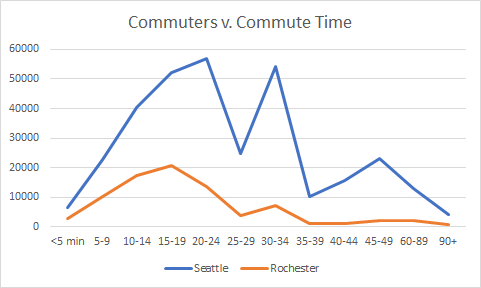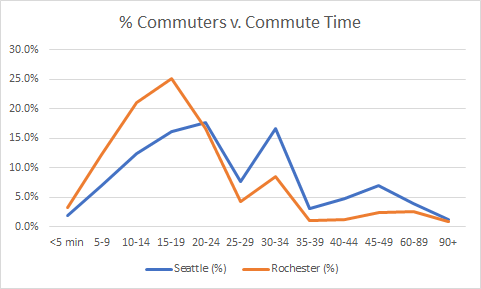It’s not hard to see why commute times figure into Amazon’s RFP for HQ2. Seattle commutes have been bad, and are getting worse. A recent study ranked Seattle the 10th worst commute in the nation, with the 3rd-fastest growing population of “mega-commuters” (90 minutes one-way).
A cursory study of the region reveals a basic reason it is difficult and expensive to address Seattle’s commute challenges: water. Seattle has Puget Sound to the west and Lake Washington to the east. Puget Sound is navigated by ferries, and Lake Washington is traversed by two (2) floating bridges because it is more than 200 feet deep. Alternative routes around those floating bridges are hard to find – too far out of the way. And it’s difficult and expensive to increase the bridges’ capacity. The new Evergreen Point floating bridge cost $4.5B and added capacity for bike/foot traffic, HOV lanes, and light rail, but no new lanes for single-occupancy vehicles. The other bridge had slightly larger capacity, but in 2017 its middle span, which had been used for reversible express lanes, was taken out of commission this year to add light rail capacity.
Suffice to say… the easiest way to deal with the floating bridges is to rarely traverse them.
You don’t always get to pick where to work, though. My old Amazon team was in Seattle, but has since moved to Bellevue. Personally, I am so averse to commuting to the Eastside that if I were still at Amazon, I would switch teams. Now about Rochester…
Rochester’s commutes are a breeze compared to Seattle, and the geography favors Rochester. Using geostat.org for source data, here’s a table contrasting Seattle and Rochester commutes – number of commuters versus length of commute time in minutes.
| Time (min) | Seattle | Rochester |
| <5 min | 6541 | 2771 |
| 5-9 | 22765 | 10148 |
| 10-14 | 40176 | 17421 |
| 15-19 | 52310 | 20710 |
| 20-24 | 56997 | 13700 |
| 25-29 | 24744 | 3587 |
| 30-34 | 54093 | 7081 |
| 35-39 | 10320 | 970 |
| 40-44 | 15572 | 976 |
| 45-49 | 22945 | 2066 |
| 60-89 | 12845 | 2143 |
| 90+ | 4091 | 805 |
| Total: | 323399 | 82378 |
Here it is in graph form.

As you can see, Rochester’s peak is both lower (fewer commuters) and peaks to the left (less commute time).
In Rochester, almost 80% of commuters travel for less than 25 minutes. In Seattle, that figure is 55%. In Seattle, 17% of commuters travel at least 40 minutes. In Rochester, that figure is 7%.
Here is another chart that compares percentages of the total – this chart makes it clearer that a higher percentage of Rochester commuters travel for less time.
 After living and working in Seattle from 1994-2002 and then 2011-2016, I think this comparison may be too favorable to Seattle!
After living and working in Seattle from 1994-2002 and then 2011-2016, I think this comparison may be too favorable to Seattle!
In fairness, the Seattle area is heavily investing in improving area transit. After decades of putting off light rail, construction began on an extensive light rail system in 2001, opening its first run in 2009 (from Sea-Tac airport to Westlake Center). A November 2016 ballot measure approved ST-3 (“Sound Transit 3”), providing for further expansion for the eye-popping sum of $54B through the year 2041.
Rochester’s transit story is admittedly not as strong as some other cities that are vying for Amazon HQ2. Many North American cities, from Washington D.C. to Boston to Chicago, have enviable rail systems that mitigate the need to drive in the city. Rochester built a small subway in the 1920s, but dismantled it in the 1950s, preferring to facilitate access to the downtown core with highways.
Rochester has been investing heavily in reconfiguring its downtown buildings to be residential or mixed-use. This trend dovetails well with Amazonians’ preference to walk to work, as 20% of the Seattle employees do. Amazonians who prefer to live in suburbs will have manageable commutes whether they are using I-390, I-490, I-590, or thoroughfares like East Avenue. With no traffic, it takes less than 10 minutes to drive from my house to the Pont de Rennes bridge in Rochester – with traffic, it takes 15. Rochester has a lot of headroom for growth before its automobile commutes start to compete with Seattle’s.
In the intermediate to long term, Rochester’s preference for downtown highway access may not be as unfavorable as one might imagine. Jeff Bezos was an early investor in Uber, which has been hard at work developing autonomous vehicle technology, which can increase road capacity by up to 3.7x. (Yes, almost four times as many vehicles per hour.) If shared, autonomous vehicles are the future, Rochester may be able to accommodate HQ2 without spending dozens of billions on light rail infrastructure.


